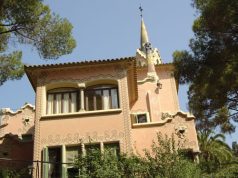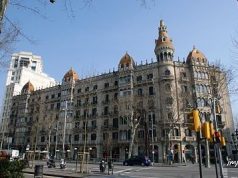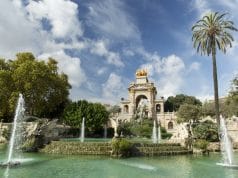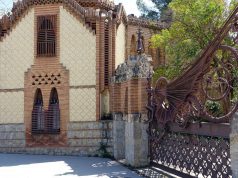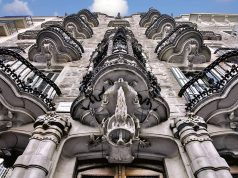The Sagrada Familia: One of the most inspiring churches in the world, that you simply must visit.
There is nothing quite like it in the world. The Sagrada Familia is one of the most iconic landmarks to visit in Barcelona. A colossal church that has been under construction for over a century, and is still not finished. The magnum opus of Antoni Gaudí, a visionary architect who devoted his life to creating this magnificent temple. It was the Sagrada Familia that would express his deep faith and love for nature. It would become be highlight of all Gaudi’s projects.
In this post, I will explore the history, design, and symbolism of the Sagrada Familia. I will also explain in detail everything you need to know before visiting the Sagrada Familia. I hope you will enjoy this journey into the world of Gaudí and his masterpiece, The Sagrada Familia.
A Brief History of the Sagrada Familia
The idea of building a church dedicated to the Holy Family (Sagrada Familia in Spanish). It was conceived by Josep Maria Bocabella. He was a devout Catholic and bookseller who founded a religious association called the Spiritual Association of Devotees of Saint Joseph. Inspired by a visit to the Vatican, he wanted to create a similar monumental church in Barcelona that would honor the patron saint of his association.
He bought a plot of land in the Eixample district of Barcelona. He then commissioned the architect Francisco de Paula del Villar to design the church. The construction began on March 19, 1882, with a neo-Gothic style. However, del Villar soon resigned due to disagreements with Bocabella. It was at this moment that the project was taken over by Antoni Gaudí in 1883.
Gaudí was a young and talented architect who had already gained some reputation for his innovative and original works. Antoni Gaudi add already designed impressive buildings such as the Casa Vicens and the Palau Güell. Gaudi accepted the challenge of building the Sagrada Familia, and transformed the project with his own vision and style. He redesigned the church with a mixture of Gothic, Art Nouveau, and Modernista elements. Gaudi also incorporated rich symbolism and organic forms inspired by his love of nature.
Gaudí dedicated the rest of his life to the Sagrada Familia, and lived in a workshop on the site. He worked on the project until his tragic death in 1926, when he was hit by a tram and died three days later. He was buried in the crypt of the church, where his tomb can be visited today.
At the time of his death, only one of the planned 18 towers was completed. At this time less than a quarter of the church was finished. The construction was interrupted by the Spanish Civil War in 1936, when the workshop was burned and many of Gaudí’s original plans and models were destroyed. The work resumed in 1940, and has continued ever since, relying on private donations and ticket sales.
The current estimate for the completion of the Sagrada Familia is around 2026, which would coincide with the centenary of Gaudí’s death. The church is currently around 80% finished, with most of the central towers completed. Work still needs to be completed on the tallest tower of which will reach 172.5 meters. This will make it the highest religious building in Europe.
The Sagrada Familia is a UNESCO World Heritage Site since 2005, and was consecrated as a minor basilica by Pope Benedict XVI in 2010. It is also the most visited attraction in Spain, with more than 4.5 million visitors per year.
The Design and Symbolism of the Sagrada Familia
The Sagrada Familia is a complex and fascinating structure that reflects Gaudí’s genius and spirituality. It is designed to have 18 towers, representing the 12 apostles, the 4 evangelists, the Virgin Mary, and Jesus Christ. The towers are arranged in a pyramidal shape, with the highest one being the tower of Jesus, which will have a cross on top and the words “Jesus Christus Rex” (Jesus Christ King) in four languages.
The church has three grand façades, each depicting a different stage of the life of Jesus: the Nativity, the Passion, and the Glory. The Nativity façade was the first one to be built, and the only one that Gaudí saw completed. The nativity facade faces east, towards the sunrise, and celebrates the birth and childhood of Jesus. It is decorated with scenes of the Annunciation, the Adoration of the Magi, the Flight to Egypt, and the Massacre of the Innocents. It also features many sculptures of animals, plants, and angels, as well as the Tree of Life, which represents the genealogy of Jesus.

The Passion façade was built between 1954 and 1976, following the drawings and plaster models left by Gaudí. This faces west, towards the sunset, and depicts the suffering and death of Jesus. It is austere and angular, with harsh lines and geometric shapes, creating a contrast with the Nativity façade. The façade shows scenes of the Last Supper, the Kiss of Judas, the Trial of Jesus, the Crucifixion, and the Burial. It also has sculptures of the apostles, the soldiers, the women of Jerusalem, and the figures of faith, hope, and charity.
The Glory façade is the largest and most ambitious one, and is still under construction. Once completed it will face south, and represent the final destiny of humanity: the resurrection, the judgment, and the glory of God. It will have seven large doors, corresponding to the seven deadly sins and the seven virtues, and will be adorned with scenes of heaven, hell, and purgatory. It will also have sculptures of the Holy Trinity, the Virgin Mary, the saints, and the people of God.
The interior of the Sagrada Familia is equally impressive and symbolic. It has a Latin cross plan, with five naves and a transept. The main nave is 60 meters high, and the side naves are 30 meters high. The ceiling is supported by 52 columns, representing the weeks of the year, and the vaults are decorated with stars, flowers, and geometric patterns.
The unique columns are designed to resemble trees, creating a forest-like atmosphere that evokes the Garden of Eden. The columns branch out at the top, forming a canopy that filters the light from the stained glass windows. The windows are arranged by color, from cooler tones in the east to warmer tones in the west, creating a chromatic effect that changes throughout the day.

The altar is located at the center of the transept, under a baldachin that represents the Holy Spirit. Above the altar, there is a large crucifix, with a figure of Jesus that seems to float in the air. The crucifix is surrounded by a hyperboloid structure, which symbolizes the light of God. Behind the altar, there is a monumental organ, with four keyboards and more than 1,400 pipes.
The Sagrada Familia also has a museum, located in the crypt and the apse. It is a great place to learn more about the history, design, and construction of the church. You can see original drawings, models, and photographs of Gaudí and his collaborators. You can also view the tools, materials, and techniques used in the building process. There is also a video that shows the evolution and future of the Sagrada Familia.
How to Visit the Sagrada Familia
If you want to visit the Sagrada Familia, you really should plan ahead and book your tickets online in advance. The tickets are sold by time slots, and they often sell out, especially during peak season. You can buy your tickets from the official website here.
There are different types of tickets available. Each ticket option will depend on what you want to see and how you want to experience the Sagrada Familia. The basic ticket costs 26 euros and includes access to the basilica and the museum, as well as an audio guide app that you can download on your smartphone. The audio guide app is available in 16 languages and provides information and explanations about the church and its symbolism.
Guided tours are an option, you can choose the ticket that costs 30 euros and includes a guided tour with an official guide, in addition to the audio guide app. The guided tour lasts about 50 minutes and is available in 7 languages: Catalan, Spanish, English, French, German, Italian, and Russian. The guided tour will give you a deeper insight into the history, design, and meaning of the Sagrada Familia. Another advantage with a guided tour is that you wil be able to ask questions when you tour the Sagrada Familia.
Another optional extra is to visit the towers, you can choose the ticket that costs 36 euros and includes access to one of the two open towers, in addition to the audio guide app. The towers are the Nativity tower and the Passion tower, and they offer different views of the city and the church. You can only visit one tower per ticket, and you have to select the tower and the time slot when you book your ticket. The access to the towers is by elevator, and the descent is by stairs. The visit to the towers is subject to weather conditions and may be canceled for safety reasons.
If you prefer to have both a guided tour and a tower visit, you can choose the ticket that costs 40 euros and includes both services, as well as the audio guide app. This is the most complete and comprehensive option to enjoy a visit to the Sagrada Familia, and one I personally recommend.
There are also some discounts and free tickets available for certain groups, such as over pensioners, students, under 30s, under 11s, people with disabilities, and companions. You can check the details and conditions on the Sagrada Familia website.
How to Get to the Sagrada Familia
The Sagrada Familia is located in the Eixample district of Barcelona, and is well connected by public transport. You can easily reach it by metro, bus, or hop-on-hop-off bus. You can also drive there, but you will need to find parking nearby, which can be difficult unless you opt for public parking.
Getting to the Sagrada Familia by metro
The metro is the fastest and most convenient way to get to the Sagrada Familia. The metro lines 2 and 5 stop at the Sagrada Familia station, which is right in front of the entrance of the basilica. You can buy a single ticket for 2.40 euros, or a 10-trip ticket for 11.35 euros, which can be used on any metro line. You can also buy a tourist travel card, which gives you unlimited access to the metro, bus, tram, and train network for a certain number of days. The prices range from 16.30 euros for 2 days to 43.70 euros for 6 days. You can buy your tickets and cards at any metro station, or online here.
Arriving By Bus to the Sagrada Familia
The bus is another option to get to the Sagrada Familia, especially if you want to enjoy the views of the city along the way. There are several bus lines that stop near the basilica, such as 19, 33, 34, D50, H10, and B24. The bus stop names are Sagrada Familia and Mallorca – Marina. You can buy a single ticket for 2.40 euros on board the bus, or use the 10-trip ticket or the tourist travel card that are valid for the metro as well. You can check the bus routes and timetables here.
By Hop-on-Hop-off Bus
The hop-on-hop-off bus is a great way to explore the main attractions of Barcelona at your own pace. You can hop on and off as many times as you want, and listen to an audio guide that provides information and commentary about the sights. The blue line of the hop-on-hop-off bus stops at the Sagrada Familia, among other places. You can buy a one-day ticket for 30 euros, or a two-day ticket for 40 euros, which include access to the three lines of the hop-on-hop-off bus. You can buy your tickets online here, or at any of the bus stops.
Arriving by car to visit the Sagrada Familia
If you prefer to drive to the Sagrada Familia, you will need to find a parking spot nearby, as there is no parking available at the basilica itself. Parking on the street is limited and expensive, as you have to pay for the blue or green zones, with a maximum of two hours. A better option is to use one of the many parking lots around the Sagrada Familia, which offer more security and convenience. However, parking in Barcelona can be very costly, so it is advisable to book your parking space in advance to save money and time. You can use this website to compare and reserve parking lots near the Sagrada Familia, with prices starting from 3 euros per hour, or 15 euros per day. Some of the closest parking lots to the basilica are:
- Parking Sagrada Familia: The best option for parking near the Sagrada Familia. It is located on Carrer de Sicília, 257, and is open 24 hours a day. It is only 220 meters away from the Sagrada Familia, and offers free cancellation and modification of your reservation. You can book your parking space here.
- Parking B:SM Mercat Sagrada Família: Located on Carrer de Mallorca, 425, and is also open 24 hours a day. It is 250 meters away from the basilica, and has electric vehicle charging points. You can book your parking space here.
- Parking Salka: This public parking is located on Carrer de Còrsega, 517-519, and is open from 7:00 am to 9:00 pm. It is 500 meters away from the Sagrada Familia, and has a car wash service. You can book your parking space here.
Conclusion
A visit to the Sagrada Família should be on the top of your list of things to do in Barcelona. It really is a once in a lifetime opportunity to view the genius of Antoni Gaudí. Our advice when you visit the Sagrada Família is purchase you tickets as quickly as possible, book a guided tour and research how you are going to get to the Sagrada Família. One last tip, try to visit on a sunny day, when the sun hits the stained-glass windows a ray of coloured light will shine through the Sagrada Família.


